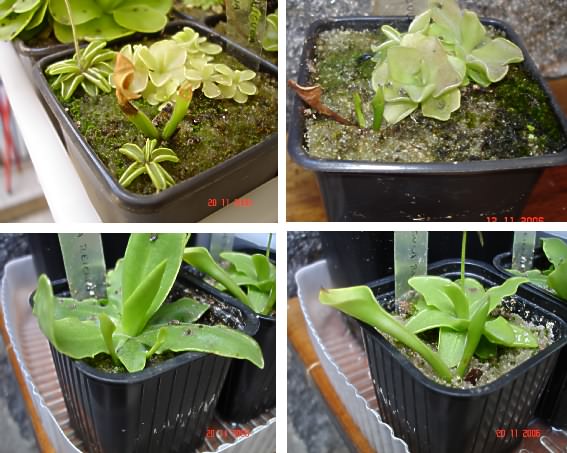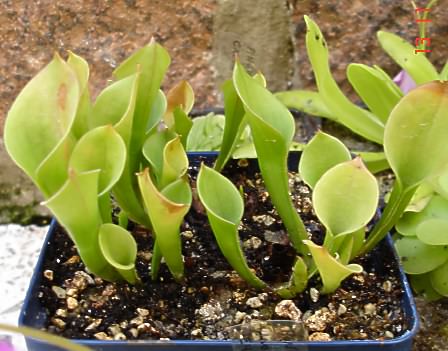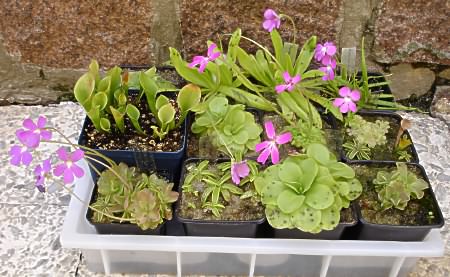Heliamphora are normally described by CP growers as plants difficult to grow and to propagate and it is not completely far from the truth since these plants came from highlands located at north of South America and there the climate is very humid and cool due to the altitude of the mountains called Tepuis where they live. To reproduce their environment seems to be very difficult but I can assure that it is not strictly necessary, after all I live in the extreme south of Brazil (30° south) very far away from the place where Heliamphora are native in a subtropical climate and I have them growing very well.
The plants are growing on the same place of my Nepenthes, Cephalotus and some Pinguicula. This room is covered by fiberglass tiles that block the direct sunlight on all plants. Only in the morning when the sunlight passes the tiles the environment is very bright but the rest of the day the bright is relatively high, meaning that Heliamphora can thrive well in environments without very high light levels. In fact I didn’t try to grow any plant in a place with higher light levels and I want to place one of them on the same place where my sarracenias live to see how the plants will behave. The pictures below show the Heliamphora growing with the pings.
The soil mix is sometimes another headache and normally it is described as a mix of various rocks, peat moss or even long fibered Sphagnum moss. Well I can assure you that a weird and complex soil recipe is really needed. When I got my first Heliamphora I tried to follow the soil mix described on the Peter D’Amato’s book The Savage Garden and at that time I had some lava rock, pumice, aqualite and long fibered Sphagnum at hand so I made the mix using them and I also added milled clay pellets. In fact these minerals are inert materials added intending just to make the soil airy – something that is not mandatory as I discovered that a simply mix of sand and long fibered Sphagnum 50/50 do the job.
What can I say about the propagation? When Peter D’Amato describes the propagation by division he says that you should ensure that the cut has its own root system. Of course I agree that it seems to be the right thing to do specially taking into account that Heliamphora are related to Sarracenia and these can be propagated by rhizome cuttings. But what would you think if I told you that it is not mandatory? Someday I was removing the dry leafs from one Heliamphora and sometimes these old leaves are still firmly fixed to the base of growing tips so when I pulled one big old leaf it broke one tip with some small leafs without any root.
Of course it was not a good sight but I had an idea based in a previous experience: when I was cleaning Sarracenia the same thing happened and by curiosity I inserted the tip in the soil of the plant pot and some time after that the tip was producing new leafs.
So if one tip of Sarracenia without roots was able to produce a new plant and as I said before that Heliamphora are related to Sarracenia why not try the same thing? By this way instead of discarding the tip I inserted it in the soil of the pot.
Now you can imagine the result: some time later I got a new Heliamphora and also discovered a different way of propagate them. Please note that it is not propagation by leaf or rhizome cutting but seems like propagation by stem cutting as used to propagate nepenthes.
You can experiment yourself this way of propagation by simply breaking one growing tip as near as possible of the rhizome and inserting it in the same pot of the mother plant or better yet: using another pot previously filled with soil mix. But be prepared to be very patient because the new leaves will sprout after one or two months later. The big advantage of this propagation method is that it avoids the stress caused on the mother plant like in the propagation by plant division.
The following pictures show some small Heliamphora nutans growing on the same pot of Pinguicula with the soil mix of sand and long fibered Sphagnum moss 50/50 and all of them came as a result of “cleaning accidents”.

| Pinguicula x 'Tina' with Heliamphora nutans | Pinguicula x 'Tina' and P. lusitanica with Heliamphora nutans |
|
Pinguicula reichen with Heliamphora nutans |
Pinguicula rundi with Heliamphora nutans |
Perhaps you are wondering why use a soil mix too different than the one composed by the suggested mix of rocks and peat or long fibered Sphagnum moss and the plants are doing well. Well, I thought about it and concluded that since these plants survive in a very inhospitable place they should be very resistant and can adapt themselves to other environments respecting the high humidity levels needed for them.
In my opinion the explanation for the easy adaptation to the soil not too well drained came from the fact that on the environment where these plants live the rain falls too frequently making the soil very damp or in the case of plants living in depressions, the collected water will make the roots be completely waterlogged for long periods due to the low evaporation rate because of the high air humidity. Of course I cannot prove if my theory is true or not, however the incontestable fact is that the Heliamphora are thriving on the same pots of Pinguicula with the sand and long fibered Sphagnum mix as proven on later pictures.
I hope that I could contribute to make the propagation and cultivation of Heliamphora easier. Now it is time for you to try these tips and have new plants.
-- João Roberto Gabbardo

Heliamphora nutans

Heliamphora nutans with Pinguicula
